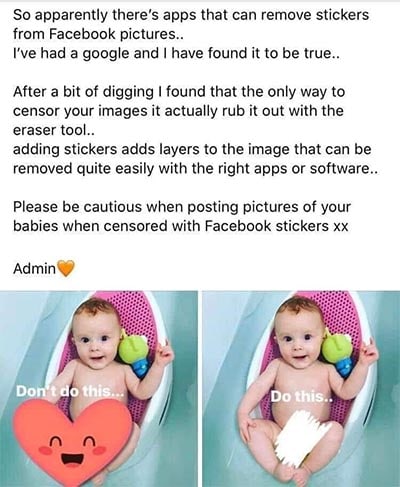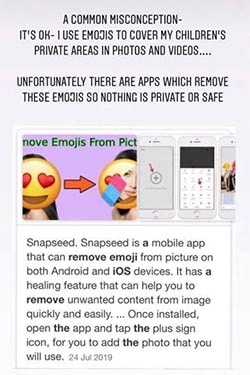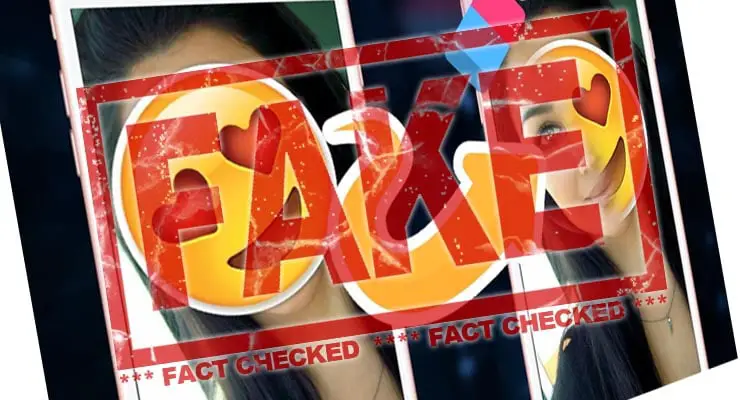Can photo editing software remove emojis from photo? Fact check
Messages online claim that there are apps available that can remove emojis or stickers placed on photos to reveal what is underneath, and that this is a reason why parents should avoid posting photos of young children on social media with emojis and stickers covering sensitive areas.
 FALSE
FALSE
Firstly, determining whether parents should post such photographs on social media in the first place falls outside the scope of this article and will not be discussed here. This article focuses on whether the claim outlined above is possible.
Examples of the claim on social media.
When taking pictures of your children and posting them online, especially Facebook, be aware that there are apps that can remove the emojis and stickers from your pictures. The first picture below is an emoji sticker provided by Facebook at the editing screen. The second picture I used the editor that came on my phone in the photos app and scratched out my face. If the editing is done on your phone to the original picture using your phone’s camera editor and not a third party app then, I believe, this protects your photo from being tampered with. DO NOT USE EMOJIS OR STICKERS TO COVER YOUR CHILD’S PRIVATE AREAS!

So apparently there’s apps that can remove stickers from Facebook pictures…
I’ve had a google and I have found it to be true..
After a bit of digging I found that the only way to censor your images it actually rub it out with the eraser tool..
adding stickers adds layers to the image that can be removed quite easily with the right apps or software..
Please be cautious when posting pictures of your babies when censored with Facebook stickers xx
Admin

The claims are false, and appear to be based on a misunderstanding of how photo editing software and JPG images work.
When you upload an image onto Facebook or Instagram or the majority of other social media platforms, in almost every circumstance, that image is going to be a JPEG (JPG) image. This is by far the most common type of image format, and it’s how most cameras and phones save images. Even if a photo you have isn’t a JPEG image, most social media platforms, including Facebook, will actually convert the image to the JPEG format. It is likely almost every photo you’ve shared on Facebook or other platforms are JPEG images.
Even if you use editing software (like the Facebook app, Instagram, Photoshop or anything else) to add emojis or stickers to a photo you’ve taken, the photo you ultimately upload to social media is still most likely a JPEG image.
JPGs store images as one single layer. This means there are no “hidden” pixels. When it comes to JPG images, there is no concept of pixels covering (or being on top of) other pixels. As such, there is no software that can erase emojis, stickers or anything else to “reveal” the pixels underneath. It is not technically possible.
Sponsored Content. Continued below...
Some file formats can retain layers, which means various parts on an image are stored on different layers and could theoretically be removed. Examples include Photoshop project files (PSD files,) some types of PDF files and files with the TIFF extension. But in the context of taking photos and uploading them to social media (with or without added emojis or stickers) these are not file types that someone would use.
I’ve heard some software can have cloning or autofill tools to remove stickers?
Most photo editing tools like Photoshop and Snapseed can have cloning and autofill tools. However, these do not remove objects to “reveal” what is underneath. As stated above, this cannot be done on a standard JPG photo.
Instead, such editing tools can – in some circumstances – give the illusion of removing objects from a photo. This is done not by actually removing the object, but by covering it up with similar pixels found elsewhere in the photo.
To help illustrate this point, take a look at the below before and after images taken from the informative PHLEARN YouTube channel (see their video here) which details how the cloning tool works in Photoshop. You can see the dog in the left photo was removed to produce the image on the right.

However, the dog wasn’t literally removed to mean the “hidden” information behind the dog suddenly becomes visible. What actually happened is that the editing software used other parts of the water, waves and beach from elsewhere on the image to cover over the dog, giving the illusion that the dog has been removed. This is called digital cloning or in the case of Photoshop, the tool is called content-aware fill.
These tools don’t reveal hidden pixels, and they need sufficient information from elsewhere in a photo to work. This means they won’t work in many situations – namely, they can’t reveal information hidden by an emoji or sticker.
Sponsored Content. Continued below...
We have seen many videos or apps that claim to offer a way to remove emojis and stickers from images. However in all cases they proved to be either pranks or used to trick people into installing software.
To surmise, removing stickers or emojis on a JPG image (or most other image file types) isn’t possible. No photo editing software can do it, for the simple reason that JPG images don’t store hidden pixels. The pixels of what lies underneath an emoji or sticker do not physically exist on a JPG image.
Continued below...
Thanks for reading, we hope this article helped, but before you leave us for greener pastures, please help us out.
We're hoping to be totally ad-free by 2025 - after all, no one likes online adverts, and all they do is get in the way and slow everything down. But of course we still have fees and costs to pay, so please, please consider becoming a Facebook supporter! It costs only 0.99p (~$1.30) a month (you can stop at any time) and ensures we can still keep posting Cybersecurity themed content to help keep our communities safe and scam-free. You can subscribe here
Remember, we're active on social media - so follow us on Facebook, Bluesky, Instagram and X
